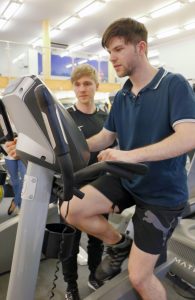The Beginners Beginning – Cardio?
As a rule, as soon as anyone mentions cardio you get mass sighs echoing all around you. Even the sound of it makes you shudder.
Cardio.
Oooh, I get goosebumps and everything.
I think the problem with cardio /cardio exercises is that it is continuous effort, and not very pretty to watch. It is not exactly sexy.
For most people, I think that it is the fact that they get out of breath, and they sweat a lot. They feel icky and sticky, all hot and bothered, and generally uncomfortable.
As if exercise was ever meant to be comfortable. I mean, pushing yourself to your physical limits sounds like a piece of cake if I am honest.
Scrap that, there is to be no cake mentioned here. Take it out of your thoughts, that cake is old and decomposed, completely inedible!

Reverse that. Let’s talk about cake, but more specifically:
Calories.
If I am going to mention such an unhealthy abomination (as if I would ever touch the stuff), then I might as well convince you of its effect on your body.
A slice (about 100g) of sponge cake is roughly 300 calories, let alone (dare I say it), chocolate cake, or even fruit cake.
In comparison to exercise, a brisk walk outside or on the treadmill will take you an hour or so to burn those 300 calories (depending on fitness and weight).
Now, just think before you have another slice of cake, even a small one. Are you willing to spend an hour on the treadmill in order to compensate for it?
For most people, that is a yes. They will neglect their diet, and would rather spend hours upon hours on cardio equipment to compensate for their bad eating habits.
As I am sure you have gathered already, this is not the way to go. Diet and cardio go hand in hand in order to decrease your body fat.
Cardio helps you to burn your fat stores, but poor nutrition makes this an uphill battle. Now, nutrition is not something that I am going to go into as it is pretty much common sense, and undoubtedly something I will cover at a later date. However, please do take this into consideration.
At least now you have some perspective as to what it takes in order to burn the calories you are consuming. Now, back to business. No more waffling.
First cake, now waffles, I hate to think how many calories you are gaining just reading this article.
How to Burn Calories:
There are several methods for fat burning and developing your fitness. For this reason I am going to strictly refer to what you can do on any piece of cardio equipment. This is advised for beginners to get a better grip of the basic principles of exercise.
The three common methods of training are:
- Continuous Training
- Interval Training
- Fartlek
These typically break down even further to target different energy systems, and therefore have different effects on the body. i.e. fat burn or target a specific type of fitness. Before that though, I will explain each of the previous examples.
Continuous Training:
Continuous training is exactly how it sounds; you perform the exercise continuously at the same pace to remain at a certain effort level. The time for this will dramatically vary depending on fitness and the target zone that you are working within. As you progress you will either want to last for longer, which is more beneficial for fat burning, or to last for the same time/distance at a higher intensity. However, most start their continuous training between 15 and 20 minutes.
Interval Training:
Another one that is pretty self-explanatory; this type of training does the same job at targeting a specific intensity. However, instead of remaining at that effort level, you will stop and rest for a specific period of time. The period of work and rest will vary depending on the intensity and the results that you want. Although this may sound like a dawdle (I’m not going to say “piece of cake” again), you are typically working harder during those work intervals.
Fartlek:
Like the others this one is all in the name, so I do not think I really need to say any more.
Ok, ok, if I really have to explain it.
Simply put, fartlek is the type of training where anything goes.
I know that is not an answer, but it is true. It is essentially any type of cardio that is not continuous or interval based. Despite this it can include aspects of the two. For example, you can have different levels of intensities. This has to be more than two, otherwise this would be interval training, unless the time periods are non-specific.
A popular use of this would be during sports training (or those cold P.E. lessons outside) where the coach has set up four cones. The athletes walk from one to the other, sprint to the next, jog to the third, and walk to the fourth, or whichever other order they decide.
The added benefit of fartlek training is that you can include any aerobic based exercise within this as well. One minute you can be doing sprints, and the next press ups, and then onto mountain climbers, all before sprinting again, or maybe even resting (if your trainer is feeling nice that is).
So now that you know what each of the training types are, you can make your decision as to which you would rather do. Following that, you then have to decide how you are going to train within that method with a specific intensity, and interval ratio if necessary.
Generally, intensity is measured by a percentage of your maximum heart rate. The lower this percentage is, the lighter the intensity, and the higher the percentage is, the harder it gets.
The Formula for Intensity:
To calculate what your Beats Per Minute should be, simply deduct your age from 220, and then times that figure by 0.? the percentage figure.
For example:
A 30 year old who would like to decrease their body fat percentage using continuous training.
220 – 30 = 190
Fat burning range = 60 – 70%
190 x 0.6 = 114
190 x 0.7 = 133
Therefore the heart rate range to be between is 114 to 133 beats per minute.
Urgh maths!
I know, I have just made you shudder again.
However, most people do not consider this step and end up not getting the results that they wanted. This is usually because they either did not work hard enough, or worked too hard.
It is unsurprising as to how many people come to me asking for help because what they are doing has not been working, and almost always, it is because they are pushing too hard. Their heart rate is too high, so they are developing their fitness rather than fat burning.
All that there is left to know now is the structure for each training type.
Continuous Training:
Similar to this article, continuous training can go on indefinitely, so it is down to you to decide how long you want to work for. Naturally, the longer you last the more your body will adapt to this by either developing your fitness and/or reducing your body fat.
I do recommend trying around 15 minutes of cardio exercises to start with. Afterwards you can then see from there whether you feel that it is enough or not. Yes, I know that you will think that it is, but remember your goals. The more you push yourself, the more real they become.
To suit your goals and ability see the list of intensities below:
Moderate Activity:
50 – 60% of your maximum heart rate
This is used for warm ups, or for those who struggle to work at higher intensities due to current fitness levels or circumstances.
Weight Management:
60 – 70% of your maximum heart rate
Otherwise known as the Fat Burning zone, this is for those looking to ignite those calories with optimum efficiency for continuous training.
Aerobic Fitness / Cardiovascular Endurance:
70 – 80% of your maximum heart rate
For ideal fitness development, it is best to work within this zone or higher. However, you do use less fat reserves, meaning that it is not as good of a fat burner.
Aerobic Performance / High Intensity CV Endurance:
80 – 90% of your maximum heart rate
This is generally unreachable except for athletes dedicated towards this level of training. An intensity too much higher than this will force the individual into a sprint as they reach maximal effort, and for most people this will nearly be there, therefore they will be unable to maintain it for the period continuous training would require.
Based upon the results that you want, this should give you an idea of where you want to be training, at least to begin with.
Interval Training:
With Interval training you have to consider the intensities and how long it will take to recover from this. Generally, the harder you work, the longer the rest period; this helps you to target a specific energy system. These energy systems supply the body with different sources of energy in order to complete various types of exercises from sprints to marathons.
To see your goals and ability see the list of intensities below and the relevant work to rest ratios:
Aerobic Interval:
3 – 5 minutes of work
1:1 Work to Rest Ratio
3 – 5 Sets
70 – 80% of your maximum heart rate for the inexperienced
75 – 85% for those who have progressed with their training
This develops Cardiovascular Endurance, noticeably at a higher intensity than standard continuous training for fitness. However, this is not for fat burning, as this energy system focuses more on oxygen intake than using up the fat stores.
Lactate Training
30 – 90 seconds of work
1:2 Work to Rest Ratio
6 – 10 Sets
90 – 95% of your maximum heart rate
This is ideal for fat burning due to the removal of oxygen as a primary energy source, and allowing the body to continue to burn even after exercise. This is also useful for any lengthy activity / sport that involves bursts of speed, strength, or power.
Creatine Phosphate (CP) Training:
10 – 15 seconds of work
1:3 Work to Rest Ratio
8 – 12 Sets
100% + (Maximal Effort – which usually cannot be measured)
This is typically for athletic ability as it involves maximal effort for speed, strength, and/or power.
Fartlek:
Unfortunately, I cannot give you much of an answer for this one in terms of intensity. It is ultimately so varied that it is impossible to tell. However, what I would say is base this training on the interval training principles to target the specific heart rates at different times. Consider at what intensity you are generally working at, and then estimate as to how much rest you then need.
You can include continuous training into this, but it is less likely, unless you are doing cross country training where the intervals are few and far between, minimising the change between pace, inclines, declines, and straights etc.
When it comes down to it, most forms of cardio can be related back to these three, and they are the ones that people do stick to due to their effectiveness. However, as you become more experienced you can start getting into training such as Tabata, High Intensity Interval Training (H.I.I.T) and Metabolic Resistance Training (MRT), which are all just elaborate forms of interval training.
Watch my videos on Youtube – EmpoweringPT videos on Youtube.
Become Empowered Today! Call 0750 333 6773 or email James Edwards.


